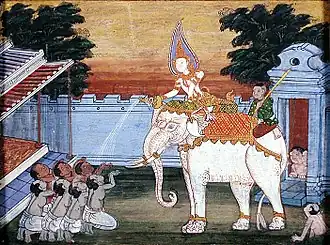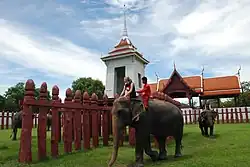Phruttibas Brahmins
Phrutthibas or Phrutthibas Brahmins are a group of Brahmins in the Thai royal court responsible for rituals related to elephants and horses.[1] They possess specialized knowledge in the care of elephants and horses, as well as in warding off evil spirits.[2] They have played a role in the Thai royal court since the Sukhothai Kingdom[2] through the Rattanakosin era.[3]
They traditionally worship a specific group of deities known as Phra Thewakam and Konchananeshwar, which do not appear in standard Hindu texts. They also revere Ganesha as "the teacher of elephant doctors".[4][5] The existence of the Phrutthibas Brahmins is considered evidence of the older Phra Thepkam religion, an indigenous Southeast Asian belief system predating full Hindu or Buddhist influence.[4][5]
History


It is believed that the Phrutthibas Brahmins originated in Cambodia.[6] Records of their role in the Thai royal court date back at least to the Sukhothai period, as evidenced by the Nakhon Chum Inscription (1900 BE).[2]
Originally, these Brahmins followed the Phra Thepkam religion, as recorded in the Kamphaeng Phet Shiva Base Inscription (2053 BE).[7] They worshipped Phra Khru Prakam (or Phi Pakam) as their chief deity, a local spirit deity later influenced by Hinduism and Buddhism.[4]
This tradition was widespread among both commoners and royalty in Thailand and Cambodia. Historical chronicles mention Khmer princes ordained as elephant doctors, such as in the Lawek Chronicle, which records Chaophraya Yom—son of King Borommaracharamathibodi—becoming an elephant doctor.[8]
Eventually, the Phra Thepkam religion was absorbed into Thai Brahmanism, and Phrutthibas Brahmins came to venerate Vishnu instead of Phi Pakam.[5][9]
Grouping
The Phrutthibas Brahmins were skilled in elephant husbandry, training, and related rituals. They were divided into three groups:[10]
- Phra Mor Tao – master teachers of the Phrutthibas.
- Mor Tao or Mor Chang – secondary teachers.
- Hasadachan or Kru Chang – trainers of elephants.
The Phra Sittichai Bodi or Phra Mor Tao rank indicated expertise in elephant rituals and scriptures (including the Atharva Veda), but not necessarily direct care of elephants.[6] Caretaking duties fell to Mor Tao and Kru Chang, who managed elephant health, behavior, taming ceremonies, and guiding wild elephants into service.[11]
Rituals
Phrutthibas Brahmins oversaw the training and care of royal elephants, including catching wild elephants for official use,[2][3] receiving and pacifying elephants before their presentation to the king,[12] and performing apotropaic rituals when death occurred in the royal palace.[2][3]
During the Ayutthaya period, manuals such as the Kachalak Textbook (elephant characteristics) and Kachakarma Textbook (training and riding) codified elephant-related knowledge.[13]
They also performed the Klobbat Somphot ground-purification ceremony, building a small shrine and burning offerings over the site of death before sealing it and symbolically removing the spirit.[14]
In elephant-related royal ceremonies, such as the Thanachai Baas ceremony for receiving a white elephant, Phrutthibas Brahmins prepared ritual dishes like Khao Pao inside a specially built Sathalin pavilion.[15]
Women of Brahmin descent in royal service also took part in auspicious rites, including reading ongkan chaeng nam chants during the Royal Swearing Ceremony, wearing white silk embroidered with silver.[16][17]
See also
References
- ^ Jintana Pincheliao. Sri Chulalak. Bangkok: Prapansan, 1981, p. 137.
- ^ a b c d e "Nakhon Chum Inscription". Sirindhorn Anthropology Centre (Public Organization). 15 July 2021. Retrieved 31 March 2024.
- ^ a b c "Brahman Phrutthibas". Public Relations Committee for the Coronation Ceremony. Archived from the original on 2024-03-31. Retrieved 31 March 2024.
- ^ a b c Siriphon Laomanacharoen (2 April 2020). "The spirit religion of Phra Thepkam at the cloister of Wat Phra Kaew". Matichon Weekly. Retrieved 27 December 2020.
- ^ a b c Siriphon Laomanacharoen (12 October 2017). "Kru Chang, Siamese Brahmin: Ganesha and Thai mythology". Matichon Weekly. Retrieved 18 November 2018.
- ^ a b Ayankhosan (2015). "Stories of Lord Ganesha related to elephants". Vajirañāṇa. Retrieved 12 May 2020.
- ^ "Kamphaeng Phet Shiva Base Inscription". Thai Inscription Database, Princess Maha Chakri Sirindhorn Anthropology Centre. Retrieved 27 December 2020.
- ^ Fine Arts Department (1938). Collection of Chronicles, Volume 71 (PDF). Bangkok Bannakarn. p. 2.
- ^ Khomkrit Uitekkeng (16 November 2017). "There are no Brahma and Ganesha in the Khon, Lakhon and Music Teacher Worship Ceremony". Matichon Weekly. Retrieved 20 October 2020.
- ^ Siri Salakot (1982). Elephant catching at the corral in Phra Nakhon Si Ayutthaya Province (PDF). Department of Archaeology, Silpakorn University. p. 10.
- ^ Cite error: The named reference
Ayanakhonwas invoked but never defined (see the help page). - ^ "Red Magic Black Sakrapee Phromchat". Post Today. 28 March 2010. Retrieved 7 September 2024.
- ^ Siri Salakot (1982). Elephant catching at the corral in Phra Nakhon Si Ayutthaya Province (PDF). Department of Archaeology, Silpakorn University. p. 11.
- ^ Kilin Paranlong (2 April 2019). "อบภาพใบหอม". ไทยรัฐออนไลน์. Retrieved 20 October 2020.
- ^ "ข้าวใช้ต่างๆ-๑". Office of the Royal Society. 10 June 2010. Retrieved 1 April 2024.
- ^ Mom Chao Jongchitthanom Diskul. Memoirs of Mom Chao Jongjitthanom Diskul. Bangkok: Watcharin Printing, 1979, p. 31.
- ^ Peerapat Petcharaban (2023). Muslim concubines in the Rattanakosin Royal Court (PDF). SWU History Journal. p. 381.